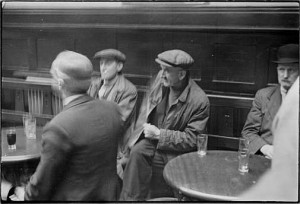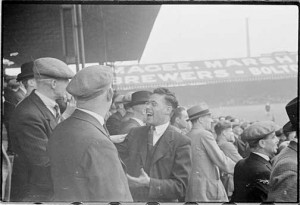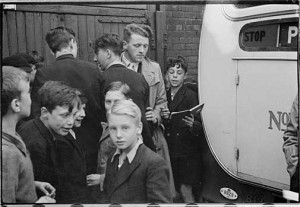
When Seebohm Rowntree ventured into the pubs of York in 1912, he was anticipating the worst. From a Quaker family, he had already crossed swords with the brewing establishment in 1901, linking adulterated beer with a string of deaths from arsenic poisoning. The link between alcohol and poverty was absolute: the pubs would no doubt prove nests of depravity and violence and he would have to be on his guard.
Misapprehension of working class life, and acting upon those misapprehensions, was and is a feature of middle class intervention in British politics. Seebohm Rowntree found York’s pubs to be gentle, sociable places, and he as a stranger was made welcome. His colleagues in the social movements of the time had been convinced, on similarly unresearched grounds, that overcrowding in cities led to sexual licence, fornication and even incest. But as more modern research has shown, the opposite was more often the case, overcrowding leading not to incest and a free-for-all, but to elevated notions of privacy, a longing for cleanliness and the protective sequestration of sexual knowledge.1
Tom Harrison’s Mass Observation project of the 1930s set out with a more open mind in many respects, and with a genuine curiousity about the lives of others, a desire to record, not shape or influence. But even they had their presuppositions: when Mass Observation followed the townsfolk on holiday to Blackpool, they expected to find adultery cases aplenty. They found two. One of them involved their own researcher! If the cap fits..
One of the great survivals of the Mass Observation project is Humphrey Spender’s Bolton photographs, and the archive has been put online in full here. Eloise Whitmore and Jonty Wilde revisited the collection and created a splendid 40 minute documentary, which you can watch in full here.
Spender’s Bolton photographs really hammer home two big principles of twentieth century history. First, candid uncomposed photographs are usually of more interest after seventy years than pictures taken with care, skill and attention. “Bad” photographs – if Spender could be accused of taking such things – capture detail that “better” pictures deliberately exclude. Image after image of the Worktown collection demonstrate this: it’s what’s on the side, or in the background, or blurred, that we want to pay attention to now. Second, British nostalgia-driven stories about the past are powerful filters, and can blind us handily to what is in front of our eyes in old photographs like these.
Take the picture above, for instance. It’s taken in the vaults underneath a Bolton public house. This was an area restricted to men only – thus were the good old days – and makes real one of the most interesting but ignored facts of British life, the decline in drinking that followed World War One. We’ve excellent statistics on the amount of alcohol drunk in Britain since the mid-to-late Victorian period. The figures show a higher-than-modern consumption of beer and spirits, often served in stronger forms than today, until 1914. Regulation then forces that figure out of the sky during the war years, as you’d expect. But the figure continues to decline, and doesn’t bottom out until 1958 or thereabouts, at a level half that of today. The level then begins a steady rise, which peaks in about 2004, since when a slight decline has begun.
The British aren’t always the comically heavy drinkers of legend. You only have to be in your forties to remember a time when the value of “holding your drink” was paramount – ensuring that, whatever your intake, you didn’t let it disturb others. Go back to the photograph above and look more closely: the men are drinking from half pint glasses.

To middle class eyes, association football of the pre-War era seems to offer unfettered access to a pure kind of working class culture, and an entire school of sport history has grown up around it. It had its origins in the History Workshop movement of the late 1960s, in which socially-concerned historians who wanted to see themselves as part of the people’s drive to the future sought to bring their craft to the assistance of the Left. It proved a frustrating exercise: working class communities are not masses sharing the same basic sets of outlooks and experiences, and historians’ resort to football came relatively late in the process because so many other areas of mass life had let Left academia down. It’s hard not to see all this, not as concern, but as control, control with psychological roots, not academic ones.
But it did hitch a free ride on the back of British nostalgia. The British place their wishes for the future in memories of the past – what they want to have, they profess to remember once having had. And the British want warm, close, lifelong communities run by principle and decency. This is how they remember industrial working class life now (and what a contrast this attitude is to the views the nation took immediately pre- and post-war..). Football plays a part in this: wishes are misrepresented as memories, and the British remember a game attended only by the cloth-capped working class poor and played by men from their own area who went to the game on the same trams and buses as the public.
I’ve written about Bolton’s Burnden Park previously and you can read that piece here. Spender’s Worktown photographs of Burnden Park tell a story that dissents from the nostalgic view. In the photograph above, there’s quite clearly a strong middle class presence – at least, a strong white collar presence – on the terraces. Football was by no means as cheap to attend as people now think – games were deliberately priced to keep the poorest out, in part a response to Edwardian football violence. The Great Depression in Britain was the first stage in the long-term move away from manual labour in the UK economy, and it should be no surprise to see that shift represented at local sporting events. But in Britain, what we want, we project into the past, and what was really there, the actual world our grandparents and great-grandparents knew, becomes obscured.

And so it goes too with the local hero playing for his town’s side and going to the game on the tram. Most casual observers would date the picture above to c. 1960. The quiffed hairstyle, the dismissive attitude to the worship of little boys, the streamlined team coach – all of these things carry a post-war air. But it isn’t 1960. It’s 1934; Herbert Chapman has only just died, and Hitler is fresh on the throne of Germany. A lot is about to happen that doesn’t have to happen. There is a sense in which everything in the photograph above has happened already; it has the look of the premature about it, as if something somewhere has jumped the gun. It’s Eddie Cochran. Isn’t it supposed to be Dvorak?
1Simon Stretter and Kate Fisher, Sex Before the Sexual Revolution: Intimate Life in England 1918-1963, (Cambridge: Cambridge University Press, 2010)

“holding your drink†was a requirement of manliness; also required was acquiring the taste for adult drink. Setting out to get rat-arsed on lager, vodka or rum-and-coke would be viewed as contemptible behaviour.
But this attitude wasn’t confined to The Working Classes: it was axiomatic to my father, for instance. And still is, largely, to me.
Very interesting. I’d read a lot about teams travelling by train, but I had a picture in my head of some interwar football team (Huddersfield Town, for some reason) travelling by bus. I probably just dreamed it, but it’s good to know it has a basis in fact. After a quick google, I now know the Arsenal travelled by bus. Any others that you know of?
Also, any idea of the identity of player and team pictured?
No idea! The closest player I’ve found in terms of looks is Wilf Mannion of Middlesbrough. But he didn’t join ‘Boro for another two years, and at the age of 16. He played with George Hardwick for England, and George Hardwick – it’s loudly alleged – had an affair with Ava Gardner. Which would probably indicate that Sunderland also travelled by coach!